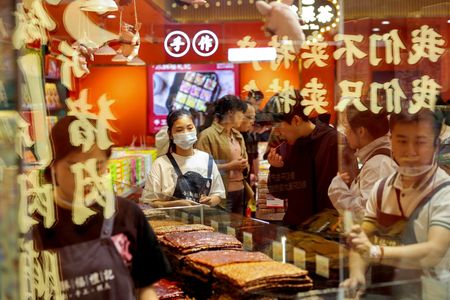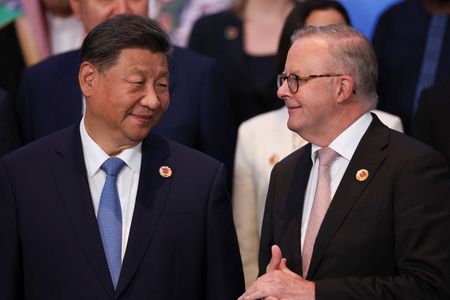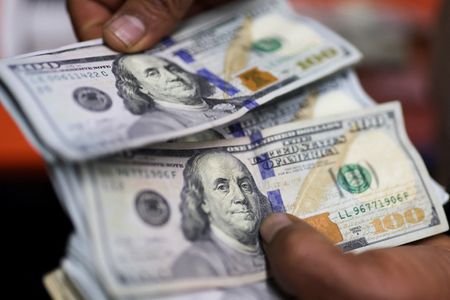By Casey Hall and Liangping Gao
BEIJING (Reuters) -Chinese travellers’ spending rose 8% year-on-year during the May Day holiday to 180.27 billion yuan ($24.92 billion), but was still off pre-pandemic levels, while the country’s services activity expanded at the slowest pace in seven months in April.
The May Day holiday, one of the country’s longest, is closely watched as a barometer of Chinese consumer confidence.
Consumption in the world’s second-largest economy has suffered amid sputtering growth and a prolonged property crisis, and the fallout from the U.S.-China trade war is set to deepen the pain.
China’s tourism ministry recorded 314 million domestic trips during the holiday, an increase of 6.5%, while the number of transactions using Weixin Pay, a popular payments app, rose by more than 10% year-on-year, with a notable increase in restaurant spending.
During the five day holiday, 10.9 million people entered and exited the country, an increase of 28.7% compared with 2024. Of this total 1.1 million were foreigners, up a sharp 43.1%, the official Xinhua news agency said.
But total spending per head over the five-day May holiday period, a typically busy time for family travel, rose just 1.5% to 574.1 yuan, Reuters calculations based on official data showed.
It remains below 2019 levels when per capita spending was 603.4 yuan.
Cinemas suffered a significant drop in ticket sales, with the box office haul over the five-day holiday at 747 million yuan, only about half of the same period in 2024.
GROWTH SLACKENING
Meanwhile, China’s services sector saw new order growth slacken from March, weighed by uncertainty caused by U.S. tariffs, a private sector survey showed on Tuesday.
Despite stronger-than-expected economic growth in the first quarter, supported by government stimulus, China’s economy continues to face persistent deflationary risks.
The Caixin/S&P Global services purchasing managers’ index (PMI), fell to 50.7 from 51.9 in March, its lowest reading since September. The 50-mark separates expansion from contraction.
This was broadly in line with China’s official survey, which showed services activity easing to 50.1 from 50.3 in the previous month. The Caixin PMI is considered a better gauge of trends among more export-oriented and smaller firms.
The Caixin services survey showed new business growth slowed to its weakest since December 2022, though export orders edged up slightly, partly due to a tourism recovery.
The drop in the Caixin PMI provides “further evidence that the trade war is weighing on economic activity in China, even beyond the manufacturing sector,” said Zichun Huang, China economist at Capital Economics.
“While some caution is clearly warranted, we suspect that firms are overestimating how much damage U.S. tariffs will do,” she said.
About 48% of employees in China worked in the services industry in 2023 and the sector contributed 56.7% to total GDP last year. But U.S. President Donald Trump’s trade actions may hit the manufacturing sector hard and hurt business hiring plans and consumer confidence.
Business sentiment in the services sector grew at the slowest pace since February 2020, with companies citing U.S. tariffs as a major concern.
Service providers cut jobs for the second straight month to curb costs, leading to a rise in work backlogs, pushing the corresponding gauge into expansionary territory for the first time this year.
Firms also reduced prices to attract customers despite higher input costs.
Lynn Song, chief economist at ING in Hong Kong, said that unlike government support policies for specific products such as appliances through a trade-in policy, there has been “limited support to boost services consumption so far”.
To bolster domestic demand, consumption vouchers could be a short term boost, while improving the quality, availability, and range of services over the long term remained key, he said.
“For consumption as a whole, it is important to restore consumer confidence to unlock savings, starting with restoring a positive wealth effect and exiting the contractionary mindset to resume reasonable wage growth.”
($1 = 7.2354 Chinese yuan)
(Reporting by Joe Cash, Casey Hall, Sophie Yu and Liangping Gao; Writing by Farah Master; Editing by Himani Sarkar, Kate Mayberry and Kim Coghill)










